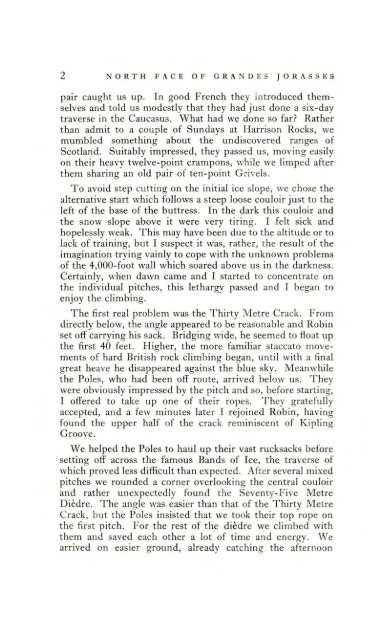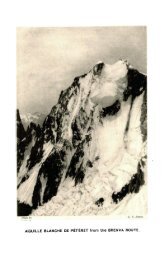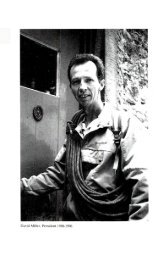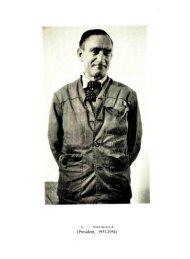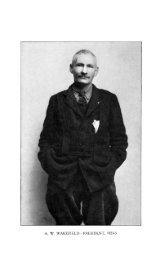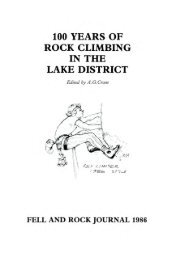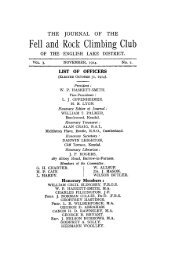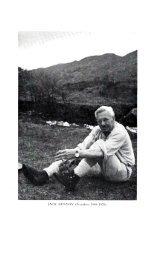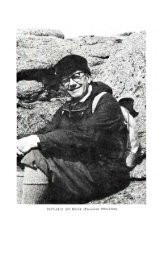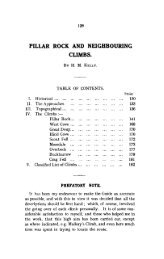Year of publication 1960 - Fell and Rock Climbing Club
Year of publication 1960 - Fell and Rock Climbing Club
Year of publication 1960 - Fell and Rock Climbing Club
You also want an ePaper? Increase the reach of your titles
YUMPU automatically turns print PDFs into web optimized ePapers that Google loves.
2 NORTH FACE OF GRANDES JORASSESpair caught us up. In good French they introduced themselves<strong>and</strong> told us modestly that they had just done a six-daytraverse in the Caucasus. What had we done so far? Ratherthan admit to a couple <strong>of</strong> Sundays at Harrison <strong>Rock</strong>s, wemumbled something about the undiscovered ranges <strong>of</strong>Scotl<strong>and</strong>. Suitably impressed, they passed us, moving easilyon their heavy twelve-point crampons, while we limped afterthem sharing an old pair <strong>of</strong> ten-point Grivels.To avoid step cutting on the initial ice slope, we chose thealternative start which follows a steep loose couloir just to theleft <strong>of</strong> the base <strong>of</strong> the buttress. In the dark this couloir <strong>and</strong>the snow slope above it were very tiring. I felt sick <strong>and</strong>hopelessly weak. This may have been due to the altitude or tolack <strong>of</strong> training, but I suspect it was, rather, the result <strong>of</strong> theimagination trying vainly to cope with the unknown problems<strong>of</strong> the 4,000-foot wall which soared above us in the darkness.Certainly, when dawn came <strong>and</strong> I started to concentrate onthe individual pitches, this lethargy passed <strong>and</strong> I began toenjoy the climbing.The first real problem was the Thirty Metre Crack. Fromdirectly below, the angle appeared to be reasonable <strong>and</strong> Robinset <strong>of</strong>f carrying his sack. Bridging wide, he seemed to float upthe first 40 feet. Higher, the more familiar staccato movements<strong>of</strong> hard British rock climbing began, until with a finalgreat heave he disappeared against the blue sky. Meanwhilethe Poles, who had been <strong>of</strong>f route, arrived below us. Theywere obviously impressed by the pitch <strong>and</strong> so, before starting,I <strong>of</strong>fered to take up one <strong>of</strong> their ropes. They gratefullyaccepted, <strong>and</strong> a few minutes later I rejoined Robin, havingfound the upper half <strong>of</strong> the crack reminiscent <strong>of</strong> KiplingGroove.We helped the Poles to haul up their vast rucksacks beforesetting <strong>of</strong>f across the famous B<strong>and</strong>s <strong>of</strong> Ice, the traverse <strong>of</strong>which proved less difficult than expected. After several mixedpitches we rounded a corner overlooking the central couloir<strong>and</strong> rather unexpectedly found the Seventy-Five MetreDiedre. The angle was easier than that <strong>of</strong> the Thirty MetreCrack, but the Poles insisted that we took their top rope onthe first pitch. For the rest <strong>of</strong> the diedre we climbed withthem <strong>and</strong> saved each other a lot <strong>of</strong> time <strong>and</strong> energy. Wearrived on easier ground, already catching the afternoon


